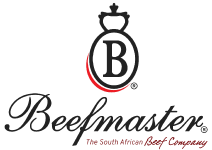
A BRIEF DESCRIPTION OF SOUTH AFRICAN CATTLE BREEDS
South African cattle breeds consist out of pure and/or mixed breeds between Bos taurus, Bos indicus (Zebu) type cattle.
Bos Taurus (or Bos taurus taurus) are the typical cattle of Europe, north-eastern Asia, and parts of Africa. Many are adapted to cooler climates.
Bos lndicus (Zebu type), sometimes known as indicine cattle or humped cattle, is a species or subspecies of domestic cattle originating in South Asia.
Zebu have a large dewlap, a fatty hump on their shoulders, and frequently drooping ears.
Popular South African Cattle Breeds: Afrikaner, Nguni, Brahman, Bonsmara, Brangus, & Simmentaler.
AFRIKANER
SCIENTIFIC NAME: TAURINE-INDICINE (“SANGA”)
The Afrikaner, also known as the Africander, is an indigenous South African cattle breed with a history dating back to 1652. Originally herded by the Khoi people, it is believed to have derived from the longhorned Zebu and the Egyptian longhorn.
Afrikaner cattle look very different from European or British breeds. They are well-muscled, with long legs and a shallow body. They have long, lateral horns that turn upwards and are well-suited to the local hot and arid conditions. Afrikaner cattle are known for their tender, juicy, and high-quality meat, making this breed popular among beef producers.
NGUNI
SCIENTIFIC NAME: BOS TAURUS
The Nguni cattle breed is unique to southern Africa. It has several advantages over other breeds, including being well-adapted to heat, tick-resistant, and immune to various tick-borne diseases, thanks to its thick, sleek, glossy hides. The breed is a hybrid of different Indian and European cattle breeds. Nguni cattle are medium-sized and have adapted well to grazing on the highveld. Although they are not the largest in size, they thrive in diverse environments, grazing on steep slopes or thick bush, and can withstand extreme weather conditions. Ngunis are adaptable and can be fattened by grazing or in feedlots.
BRAHMAN
SCIENTIFIC NAME: BOS TAURUS INDICUS
The Brahman, originating from India, is a strong commercial contender in the livestock industry. Over the years, the breed has been exposed to various diseases and weather conditions, allowing it to adapt to different environments and climates. A distinctive characteristic of the Brahman is its large hump on the shoulder and loose skin, which helps cool its body surface. The genetics of the Brahman are widely used in beef production worldwide. Beef from this breed is prized for its lean quality, as Brahman carcasses have minimal fat.
BONSMARA
SCIENTIFIC NAME: BOS TAURUS INDICUS
The Bonsmara breed, one of the most prominent beef breeds in the country, was originally scientifically bred for economic reasons. British breeds brought to South Africa were not tolerant of the heat and overall climate. Thus, between 1937 and 1963, the Afrikaner, Hereford, and Shorthorn were crossbred until the ‘perfect’ breed was established: the Bonsmara. The Bonsmara’s meat is renowned for its high quality. The breed is incredibly fertile, calves with ease, and its calm temperament makes it easy to handle.
BRANGUS
SCIENTIFIC NAME: BOS TAURUS
Originally bred in the United States in the 1940s, the Brangus is a cross between the Angus—best known for its superior carcass qualities—and the Brahman, a hardy breed with developed disease resistance. Brangus cattle are resistant to heat and humidity, yet hardy in colder climates. They gain weight rapidly as they are good foragers and mature late. Today, Brangus herds are found in various parts of the world, including South Africa, where it is currently the fourth largest breed in the country.
SIMMENTALER
SCIENTIFIC NAME: BOS TAURUS PRIMEGENIUS
Simmentalers originated in Switzerland and have a low relationship with Zebu, or humped cattle. The breed is perfect for crossbreeding due to its hybrid vigor or heterosis. Simmentalers can be found in most South African climates and are well-adapted to the tough African conditions. The first Simmental cattle arrived in South Africa in 1905 and have since spread widely throughout the country due to their crossbreeding characteristics. They produce heavy carcasses with a high beef yield.


